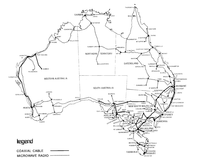


Chapter 8
I Part 1: Communications
i Before the Telegraph
ii Electrical Communication Before Federation
iii Federation to the End of the Second World War
iv Post-war and on to 1975
v 1975 ONWARDS
II Epilogue
III Part 2: Early Australian Computers And Computing
IV Acknowledgements
References
Index
Search
Help
Contact us

1975 ONWARDS (continued)
The provision of TV and radio services to the balance of the remote areas had to wait until Aussat introduced its direct broadcasting service. In another development, the establishment of multicultural TV services by the Special Broadcasting Service commenced in 1980 and involved the use of the VHF and UHF bands of frequencies.Progress in electronics enabled the development of low power consumption, highly reliable microwave equipment by a number of manufacturers. This, together with the application of solar energy to provide primary power for loads up to 140 watts, facilitated new approaches to the design of Radio Relay Systems for the remoter areas of Australia. A. J. Mencel[67] has described the first such system in Australia installed between Alice Springs and Tennant Creek in 1980. It involved thirteen solar powered repeaters, housed in below ground shelters to ensure small ambient temperature variations without air-conditioning.

A similar approach was taken to the engineering of microwave systems, both extending through the Cape York Peninsula in Queensland and in the Kimberley Region of West Australia and on to Darwin. This latter section completed an around Australia broadband network, giving added resilience and diversity to the communication system. In the case of international communications, a burgeoning technology, increasingly influenced by digital and computer techniques, producing more and better quality communication channels at reducing real cost, remained a strong driving force. At the same time, market considerations began to impact in a much greater way on investment decisions and on the timing of new and improved services. Growth in telephony dominated throughout the decade but increasingly significant numbers of calls made over the telephone service carried non-voice traffic, such as facsimile or low speed data. Specialised data services were also introduced and TV relaying became an everyday occurrence, with events around the world brought live to homes throughout Australia, while important Australian happenings could also be viewed in other countries. Telex remained an important service but at lower growth rates and on the other hand, the original telecommunications service, telegrams, continued its decline, a casualty of the new technologies and services.

Organisations in Australian Science at Work - AUSSAT Pty Ltd; Australian Broadband Network; Special Broadcasting Service (S.B.S.); Telecom Australia (Australian Telecommunications Commission)
People in Bright Sparcs - Mencel, A. J.
 |
Australian Academy of Technological Sciences and Engineering |  |
© 1988 Print Edition page 596, Online Edition 2000
Published by Australian Science and Technology Heritage Centre, using the Web Academic Resource Publisher
http://www.austehc.unimelb.edu.au/tia/575.html